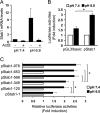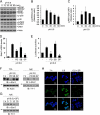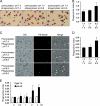Extracellular low pH modulates phosphatidylserine-dependent phagocytosis in macrophages by increasing stabilin-1 expression
- PMID: 22334667
- PMCID: PMC3322863
- DOI: 10.1074/jbc.M111.310953
Extracellular low pH modulates phosphatidylserine-dependent phagocytosis in macrophages by increasing stabilin-1 expression
Abstract
Microenvironmental acidosis is a common feature of inflammatory loci, in which clearance of apoptotic cells is necessary for the resolution of inflammation. Although it is known that a low pH environment affects immune function, its effect on apoptotic cell clearance by macrophages has not been fully investigated. Here, we show that treatment of macrophages with low pH medium resulted in increased expression of stabilin-1 out of several receptors, which are known to be involved in PS-dependent removal of apoptotic cells. Reporter assays showed that the -120/-1 region of the mouse stabilin-1 promoter was a low pH-responsive region and provided evidence that extracellular low pH mediated transcriptional activation of stabilin-1 via Ets-2. Furthermore, extracellular low pH activated JNK, thereby inducing translocation of Ets-2 into the nucleus. When macrophages were preincubated with low pH medium, phagocytosis of phosphatidylserine-exposed red blood cells and phosphatidylserine-coated beads by macrophages was enhanced. Blockade of stabilin-1 in macrophages abolished the enhancement of phagocytic activity by low pH. Thus, our results demonstrate that a low pH microenvironment up-regulates stabilin-1 expression in macrophages, thereby modulating the phagocytic capacity of macrophages, and suggest roles for stabilin-1 and Ets-2 in the maintenance of tissue homeostasis by the immune system.
Figures







Similar articles
-
The conserved histidine in epidermal growth factor-like domains of stabilin-2 modulates pH-dependent recognition of phosphatidylserine in apoptotic cells.Int J Biochem Cell Biol. 2010 Jul;42(7):1154-63. doi: 10.1016/j.biocel.2010.03.024. Epub 2010 Apr 9. Int J Biochem Cell Biol. 2010. PMID: 20382256
-
Stabilin-1 mediates phosphatidylserine-dependent clearance of cell corpses in alternatively activated macrophages.J Cell Sci. 2009 Sep 15;122(Pt 18):3365-73. doi: 10.1242/jcs.049569. J Cell Sci. 2009. PMID: 19726632
-
Rapid cell corpse clearance by stabilin-2, a membrane phosphatidylserine receptor.Cell Death Differ. 2008 Jan;15(1):192-201. doi: 10.1038/sj.cdd.4402242. Epub 2007 Oct 26. Cell Death Differ. 2008. PMID: 17962816
-
Stabilin Receptors: Role as Phosphatidylserine Receptors.Biomolecules. 2019 Aug 20;9(8):387. doi: 10.3390/biom9080387. Biomolecules. 2019. PMID: 31434355 Free PMC article. Review.
-
Stabilin-1, a homeostatic scavenger receptor with multiple functions.J Cell Mol Med. 2006 Jul-Sep;10(3):635-49. doi: 10.1111/j.1582-4934.2006.tb00425.x. J Cell Mol Med. 2006. PMID: 16989725 Free PMC article. Review.
Cited by
-
Carbonic anhydrase 2 deficiency leads to increased pyelonephritis susceptibility.Am J Physiol Renal Physiol. 2014 Oct 1;307(7):F869-80. doi: 10.1152/ajprenal.00344.2014. Epub 2014 Aug 20. Am J Physiol Renal Physiol. 2014. PMID: 25143453 Free PMC article.
-
TM4SF19-mediated control of lysosomal activity in macrophages contributes to obesity-induced inflammation and metabolic dysfunction.Nat Commun. 2024 Mar 30;15(1):2779. doi: 10.1038/s41467-024-47108-8. Nat Commun. 2024. PMID: 38555350 Free PMC article.
-
Role of pH-sensing receptors in colitis.Pflugers Arch. 2024 Apr;476(4):611-622. doi: 10.1007/s00424-024-02943-y. Epub 2024 Mar 22. Pflugers Arch. 2024. PMID: 38514581 Free PMC article. Review.
-
The material and biological characteristics of osteoinductive calcium phosphate ceramics.Regen Biomater. 2018 Feb;5(1):43-59. doi: 10.1093/rb/rbx024. Epub 2017 Sep 8. Regen Biomater. 2018. PMID: 29423267 Free PMC article. Review.
-
Acidification of the intimal fluid: the perfect storm for atherogenesis.J Lipid Res. 2015 Feb;56(2):203-14. doi: 10.1194/jlr.R050252. Epub 2014 Nov 25. J Lipid Res. 2015. PMID: 25424004 Free PMC article. Review.
References
-
- Dubos R. J. (1955) The micro-environment of inflammation or Metchnikoff revisited. Lancet 269, 1–5 - PubMed
-
- Grimshaw M. J., Balkwill F. R. (2001) Inhibition of monocyte and macrophage chemotaxis by hypoxia and inflammation. A potential mechanism. Eur. J. Immunol. 31, 480–489 - PubMed
-
- Edlow D. W., Sheldon W. H. (1971) The pH of inflammatory exudates. Proc. Soc. Exp. Biol. Med. 137, 1328–1332 - PubMed
Publication types
MeSH terms
Substances
LinkOut - more resources
Full Text Sources
Research Materials

